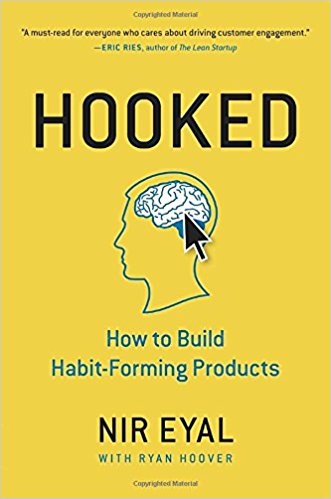Hooked Summary

5 min read ⌚
 How to Build Habit-Forming Products
How to Build Habit-Forming Products
You live a life that is formed by your habits.
In the following summary of “Hooked,” we will show you how you can create and advertise products in a way that gets your customers hooked on it.
Read on to find out all aspects of the Hook Model.
Who Should Read “Hooked”? and Why?
The morning coffee, the three alarms that wake you up, check your e-mail as soon as you open your eyes – these actions are all habits.
You perform these activities with little or no thought, and you feel that it is just the way you live your life. You are “Hooked”.
Author Nir Eyal teaches you how to use the habit-forming process to hook your customers to your products and services.
We are confident that “Hooked” will hook entrepreneurs, designers, and marketers.
So, what are you waiting for? Read on.
About Nir Eyal
 Nir Eyal is a video-gaming and advertising industry veteran. He writes, speaks and teaches about applied consumer psychology.
Nir Eyal is a video-gaming and advertising industry veteran. He writes, speaks and teaches about applied consumer psychology.
“Hooked Summary”
Every day, you act based on habit.
You complete these habitual behaviors and actions with little or no thought. When your habit is connected to using a service or product, like using a smartphone, or Instagram, the company that owns that service or product notices a significant win.
Marketers do everything they can to design the customer experience in a way that it becomes ingrained. They do so because for a product to be successful, it requires loyal, habitual users.
Smartphones, game consoles, and other handheld devices give clients an ongoing and constant access and connectivity.
Marketers have two available tools at their hand for transforming their customers’ behavior into forming a habit: the constant entrée and detailed personal data gathered through data mining.
Investors compute an organization’s “client lifetime value” (CLTV) to understand their overall value.
How can we define CLTV?
It is the amount of cash a business believes it will make from a particular client during his or her lifetime.
The more habit-forming an item is, the higher its CLTV the business can expect to be.
As purchasers accept a product and incorporate it into their lifestyles, their resistance toward the increase in its cost declines.
Loyal clients share their experience regarding the products they habitually enjoy and review and recommend them via social networks.
Businesses habit-forming marketing offerings fight off rivalry.
New market entrants think that it is hard to change purchasers’ implanted behaviors, even at times when they offer a superior item.
Take the QWERTY keyboard for example. It was created in the 1870s for the first typewriters. Ever since then, people created better layouts, but people did not adopt them.
Such is the case because once people become capable of typing on a QWERTY keyboard, they are disinclined to learn another system, regardless of whether it is more productive.
Key Lessons from “Hooked”:
1. The “Habit Zone”
2. The “Hook Model”
3. Assess and Follow Up
The “Habit Zone”
The Habit Zone is the sweet spot situated between the frequency of a behavior and the perceived convenience and ease of use. Products and services fall into one of the two categories: vitamins and painkillers (metaphorically speaking).
Vitamins are products which bring satisfaction and are surely nice to have, but people can live without them. People feel great when they have a vitamin product, but they do not feel terrible if they do not.
On the other hand, people feel pain when painkiller products are not available. When something becomes your habit, having it out of reach hurts.
The “Hook Model”
The Hook Model is a four-step process that can help businesses hook their customers on their offerings. People who get hooked will use that product or service repeatedly, making marketing less necessary.
- “Trigger: The Actuator of Behavior”
Triggers initiate your behavior. They are motivators that push people to take certain kinds of actions.
Triggers can be internal or external.
External categories are divided into four groups: paid, earned, relationship, and owned.
Internal triggers are subconscious connections between a thought or action and emotion.
- “Action: The Behavior Done in Anticipation of a Reward”
Action is what triggers motivate. In other words, an action is a way you behave because you expect a certain award. When it comes to habits, people act instinctively, without giving the action much thought.
Dr. B.J. Fogg has developed his “Fogg Behavior Model” in which he presents the formula “B=MAT”: “Behavior” happens in the presence of sufficient “Motivation,” and “Ability” plus “a Trigger.”
Fogg places human motivators into three categories: “To seek pleasure and avoid pain; to seek hope and avoid fear; to seek social acceptance and avoid rejection.”
- “Variable Reward: The Hook’s Ability to Create a Craving”
Craving is what the Hook Model uses to create your desire.
Once people act, they feel the relief of having their urges satisfied or their problems solved.
Research into reward behavior has shown that expecting an award activates the brain’s pleasure center.
Variable awards fall into three types: “the tribe, the hunt, and the self.”
- “Investment: The User Does a Bit of Work”
When you invest yourself in an effort, you become more committed to your purchase. Or, simply said, people usually develop habits concerning products or services that they use.
Even slight investments of energy or time create strong bonds.
At the point when people commit to a particular behavior, they are more likely to repeat it in the future. The more energy and time a customer invests in your product, it is more likely that they will keep using it.
Assess and Follow Up
If you decide to use the Hook Model, study your motivations to make sure that you are not exploiting others to gain an advantage, and that you have the proper purposes.
The “Manipulation Matrix” is a chart consisting of four-quadrants that helps you study your motives for using the Hook Model.
-
- “The Facilitator” is a creator who trusts their service or product makes a positive contribution, and who would go ahead and use it himself.
-
- “The Peddler” is a seller who believes that the product or service he offers has some value, but would not necessarily use it himself.
-
- “The Entertainer” looks at the business at a “hits-driven” process.
- “The Dealer” is a manipulator who uses what they offer as a way to make money.
Like this summary? We’d Like to invite you to download our free 12 min app, for more amazing summaries and audiobooks.
“Hooked” Quotes
79 percent of smartphone owners check their device within 15 minutes of waking up every morning. Share on X Users who continually find value in a product are more likely to tell their friends about it. Share on X Companies who form strong user habits enjoy several benefits to their bottom line. Share on X Many innovations fail because consumers irrationally overvalue the old while companies irrationally overvalue the new. Share on X The mind takes shortcuts informed by our surroundings to make quick and sometimes erroneous judgments. Share on XOur Critical Review
Nir Eyal created the “Hook Model” by analyzing the traits that successful products have in common, drawing insights from neuroscience, behavioral psychology and his personal experience in gaming and advertising. Although this model is particularly suitable for digital products, all products can benefit from it.








